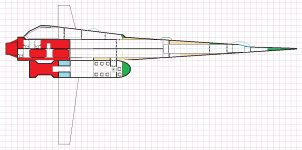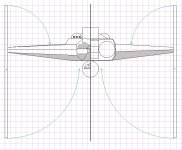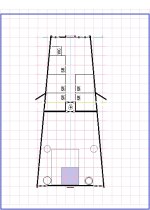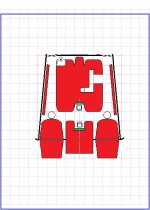Personal taste here: Blunt the nose back to the original drawing. It will give you more room for the avionics and computer plus, soften the underbelly slightly.
I'm trying to replicate the illustration (see page one of this thread) even if it's awkward. Honestly, I'm not quite sure the flight deck and its domes actually work out geometrically -- but they're there, so I'll let it go. The computer is just aft of the bridge; there's a walkway through it. The "rest of the bridge" is in the crawlspace forward of the missile turrets that's ahead of the missile magazine, and as antennae in the wingtip fins.
I don't know what the fins were meant to be, other than artistic flair. They don't make
aerodynamic sense, even if the rest of the ship could work.* They're either antenna housings or have something to do with the Jump Drive, and nothing in canon suggests the latter. So, that's where the antennae are, and that's bridge tonnage.
Clean sheet design? I'd replace the deck and domes with bubble canopies, and if needed add an inverted V-tail instead of the tip fins.
This will also allow the area necessary for the landing gear and mooring claps for the launch. The other point here is the upper hatch (round hatch or hatch in roof of launch) square it, so more cargo can go through it. Take a look at my Gigs in the Gazelle Study to see what I finally mean.
The hatch in the roof is solely for personnel access. It's there so the ship's boat can dock with its deck at the same orientation as that of the parent ship for convenience (personnel don't have to re-orient on exit, and more important, it saves having to explain the process to players...)
Finally, if you have a hatch in the roof, there is no need to turn the launch on it's side to unload cargo. Both the side airlock and that hatch serve the same purpose. You're not going to fit anything but boxes though both anyhow. A 1 Ton Cargo container is not going to fit through the airlock door.
If you're transferring cargo, rotate the Ship's boat in the docking clamps to pass cargo out through the big door, as shown. You'll probably want to turn off the gravity first! It can't have both a side and roof hatch of that size (they'd interfere), and the standard one has it on the side.
By moving the freight elevator up out of the way and removing/retracting the outlined area on the middle deck floor, it's possible to get a block of cargo that exactly fills the ship's boat's cargo hold (4.5m wide, 6m long, 3m tall) into the ship's cargo hold. Slide it in, tip it over, and slide it onto whichever deck you want to store it on.
Advise: Short and broaden the winglets to just below the Launch. You can store one set of landing gear in there. Plus, if the you're running low on fuel or need extra fuel to refuel all those vehicles on board, the winglets can act as an extra fuel tank.
Again, I'm trying to replicate the illustration -- If I were starting with a clean sheet, I wouldn't even have them! But they're there, so I have to make them work.
In the Gull Class Survey Vessel, the long lower winglets serve that purpose, thou, I never stated it or showed it. Making the launch more aerodynamic seem a good idea to. Use a gig from the Gazelle or Fiery, maybe the launch from Subsidized Merchant. I believe every depicting I've looked at has refueling scoops and it would help in atmospheric reentry.
Question: Do you still have a Ship's Boat in the design or did you remove it in place of the Launch?
It's a ship's boat from S7: Traders and Gunboats, with only the extra personnel hatch added.
The hard part's are over and now the fun begins. Make the design you're own since, the publisher didn't get it right the first time around. AND if you're off a few tons, screw it.
The thing is, the publisher got it right for what they were doing: making a set of plans that could be printed and produced. What they got wrong was that the plans weren't for the ship pictured on the box...
I'm drawing the plans for the ship pictured on the box.

I suppose the flip side of it is to then go on to draw pictures of the ship that the FASA deck plans describe, except that I'm pretty sure it wouldn't look nearly as good...
---------------------
* First, they aren't far enough aft of the center of mass to provide lateral stability -- no moment arm. Second, having the lower fins longer than the top ones induces adverse roll with yaw (point the nose right and the ship will roll to the
left, which is destabilizing). Third, they're far too tall to just be end plates, and the wings are too sharply tapered to be generating much lift out there at the tips anyhow.
(I used to design radio controlled model airplanes, so this sort of thing bothers me more than it would most people.)





